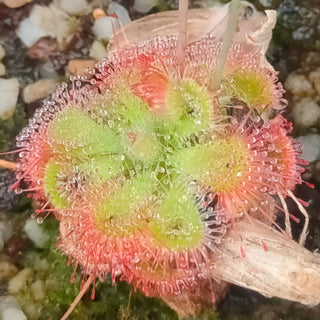Callistemon citrinus, Callistemon lanceolatus
CRIMSON BOTTLEBRUSH
- Unit price
- / per
Melaleuca citrinus, the common red bottlebrush, crimson bottlebrush, or lemon bottlebrush, is a hardy and adaptable species, common in its natural habitat of Australia and widely cultivated around the world. Its showy red flower spikes, present over most of the year in an ideal situation, account for its popularity.
Melaleuca citrinus grows to 5 m (20 ft) tall but more usually in the range 1-3 m (3-10 ft) high and wide. The flowers are red and arranged in spikes on the ends of branches. The spikes are up to 45-70 mm (2-3 in) in diameter and 60-100 mm (2-4 in) long with up to 80 individual flowers.
Birds have been observed using the species as a source of food. Those seeking nectar from the flowers include eastern spinebills, New Holland honeyeaters, noisy miners, red wattlebirds and silvereyes, while crimson rosellas eat the seeds.
Type: Shrub or small tree
Hardiness zones: 9-11
Location: Sun
Seed size: These seeds are naturally very small
Seeds per packet: 20
Surface sow as light aids germination. Water the seeds in. Keep continuously moist. Temperature 20-22 C, 68-72 F. Germinates in 10-30 days.
Callistemon citrinus, Callistemon lanceolatus
CRIMSON BOTTLEBRUSH
- Unit price
- / per
Multiple secure payment options available.
Adding product to your cart
You may also like
Melaleuca citrinus, the common red bottlebrush, crimson bottlebrush, or lemon bottlebrush, is a hardy and adaptable species, common in its natural habitat of Australia and widely cultivated around the world. Its showy red flower spikes, present over most of the year in an ideal situation, account for its popularity.
Melaleuca citrinus grows to 5 m (20 ft) tall but more usually in the range 1-3 m (3-10 ft) high and wide. The flowers are red and arranged in spikes on the ends of branches. The spikes are up to 45-70 mm (2-3 in) in diameter and 60-100 mm (2-4 in) long with up to 80 individual flowers.
Birds have been observed using the species as a source of food. Those seeking nectar from the flowers include eastern spinebills, New Holland honeyeaters, noisy miners, red wattlebirds and silvereyes, while crimson rosellas eat the seeds.
Type: Shrub or small tree
Hardiness zones: 9-11
Location: Sun
Seed size: These seeds are naturally very small
Seeds per packet: 20
Surface sow as light aids germination. Water the seeds in. Keep continuously moist. Temperature 20-22 C, 68-72 F. Germinates in 10-30 days.
















































